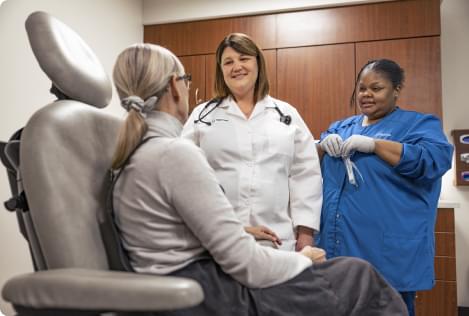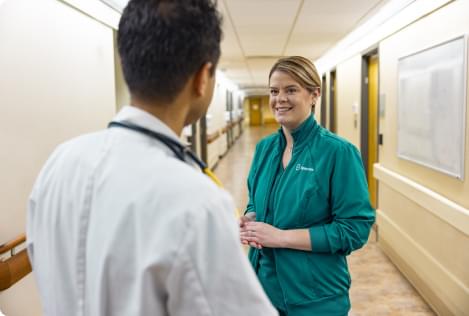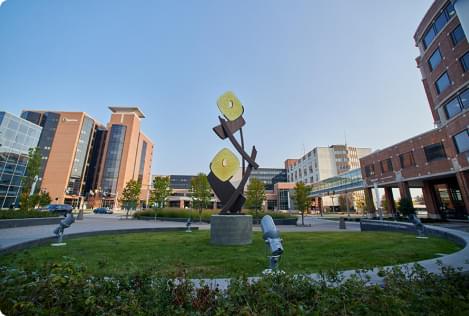Overview
Primary lateral sclerosis (PLS) is a type of motor neuron disease. A motor neuron disease affects the nerve cells in the brain that control movement. In PLS, the breakdown of nerve cells causes weakness in the muscles that control the legs, arms and tongue.
Symptoms typically begin with balance trouble. People with PLS may move slowly and are clumsy. Over time, symptoms evolve to include having trouble with their hands and arms, followed by problems with chewing, swallowing and speaking. Less commonly, the condition may begin with problems with speaking and swallowing.
This rare condition can develop at any age, but it usually occurs between ages 40 and 60. PLS is more common in men than in women. Rarely, PLS can begin in early childhood. This subtype is known as juvenile primary lateral sclerosis. Juvenile PLS is caused by a change in a gene that's passed from both parents to a child.
PLS is often mistaken for another, more common motor neuron disease called amyotrophic lateral sclerosis (ALS). While likely related to ALS, PLS gets worse more slowly than ALS. In most people, PLS isn't fatal.
Symptoms
Symptoms of primary lateral sclerosis usually take years to develop and get worse. Symptoms generally begin in the legs. Rarely, PLS begins with weakness in the tongue or hands. Then weakness gradually moves down the spinal cord to the legs. However, symptoms vary from person to person. Symptoms may include:
- Stiffness, weakness and muscle spasms in the legs. This is known as spasticity. Rarely, spasticity starts in only one leg and moves to the arms, hands, tongue and jaw.
- Slowed movement.
- Tripping, being clumsy and having trouble with balance.
- Hand clumsiness.
- A hoarse voice, as well as slowed, slurred speech and drooling.
- Trouble chewing and swallowing.
- Sometimes, frequent, rapid and intense shifts in emotions.
- Rarely, breathing problems and bladder problems late in the disease.
When to see a doctor
Make an appointment to see a health care professional if you have persistent problems with stiffness or weakness in your legs or arms. Also see a health care professional if you have trouble swallowing or speaking.
Take your child to a health care professional if your child develops muscle spasms or seems to be losing balance more often than usual.
Causes
In primary lateral sclerosis, the nerve cells in the brain that control movement slowly break down and stop working. These nerve cells are called upper motor neurons.
As a result, the nerves are not able to activate the motor neurons in the spinal cord, which control voluntary muscles. This loss causes movement problems. People with PLS may have problems with balance, weakness, slowed movement and clumsiness. PLS also may cause problems with speech and swallowing.
Adult-onset primary lateral sclerosis
The cause of PLS that begins in adulthood is not known. In most people, the disease is not inherited. It's not known why or how it begins.
Juvenile primary lateral sclerosis
Juvenile PLS is caused by changes in a gene called ALS2.
Researchers don't understand how this gene causes the disease. But they know that the ALS2 gene gives instructions for creating a protein called alsin. Alsin is present in motor neuron cells. When the instructions are changed in someone with juvenile PLS, the protein alsin becomes unstable and doesn't work properly. This affects the function of the muscle.
Juvenile PLS is an autosomal recessive inherited disease. This means both parents have to be carriers of the gene to pass it to their child. However, they don't need to have the disease themselves.
Risk factors
There are no established environmental risk factors for primary lateral sclerosis.
Complications
It can take as long as 20 years for primary lateral sclerosis to progress and become worse. Symptoms vary from person to person. Some people continue to walk, but others eventually need to use wheelchairs or other assistive devices.
For most people, adult-onset PLS isn't thought to shorten life expectancy. But it can gradually affect the quality of your life as more muscles become disabled. Weaker muscles can cause you to fall, which can result in injuries. Problems with chewing and swallowing may result in poor nutrition. Performing activities of daily living, such as bathing and dressing, may become hard.
People with PLS may develop problems with their thinking, known as cognitive decline. Or they may have changes in their behavior. For some people, their symptoms overlap with symptoms of frontotemporal dementia.
Diagnosis
There is no single test that confirms a diagnosis of primary lateral sclerosis (PLS). PLS can have symptoms similar to other neurological diseases such as multiple sclerosis and ALS. For this reason, you'll likely need several tests to rule out other diseases.
A health care professional first takes a careful record of your medical history and family history and performs a neurological exam. Then you may have the following tests:
- Bloodwork. Blood tests check for infections or other possible causes of muscle weakness.
- MRI. An MRI or other imaging tests of your brain or spine might reveal signs that nerve cells have broken down. An MRI also can show other causes of symptoms, such as structural problems, multiple sclerosis or spinal cord tumors.
-
Electromyogram (EMG). The test evaluates the electrical activity of muscles when they contract and when they're at rest. This test also measures the involvement of lower motor neurons. This can help tell the difference between PLS ⸺ an upper motor neuron disease ⸺ and ALS, which affects both upper and lower motor neurons.
During an EMG, your doctor inserts a needle electrode through your skin into different muscles.
- Nerve conduction studies. This test can determine if you have nerve damage. A low amount of electrical current measures your nerves' ability to send impulses to muscles in different areas of your body.
- Lumbar puncture, also known as a spinal tap. A spinal tap can help rule out multiple sclerosis, infections and other conditions. A thin, hollow needle inserted into your spinal canal removes small samples of cerebrospinal fluid. This is the fluid that surrounds your brain and spinal cord. The samples are then analyzed in a lab.
Sometimes it takes 3 to 4 years before a diagnosis can be made. This is because early ALS can look like PLS until other symptoms surface a few years later. You might be asked to return for repeat EMGs over 3 to 4 years before a PLS diagnosis is confirmed.
Genetic testing may be done when juvenile PLS is suspected. Genetic counseling also may be recommended.
Treatment
There are no treatments to prevent, stop or reverse primary lateral sclerosis. Treatment focuses on relieving symptoms and preserving function.
Medication
You might take medicine to relieve these symptoms:
-
Muscle spasms, known as spasticity. Muscle spasms may be relieved by baclofen (Fleqsuvy, Ozobax, Lyvispah), tizanidine (Zanaflex) or clonazepam (Klonopin). These medicines are taken by mouth.
If muscle spasms aren't controlled with oral medicine, your health care professional might recommend surgery to implant a medicine pump. The pump delivers baclofen directly to the spinal fluid.
- Emotional changes. You may be prescribed an antidepressant if you have frequent, rapid and intense shifts in emotions.
- Drooling. Drooling may be helped by amitriptyline or other medicines.
Physical and occupational therapies
Stretching and strengthening exercises can help maintain muscle strength, flexibility and range of motion. The exercises also may help prevent joint immobility.
Speech and language therapy
Speech therapy might help with communication and swallowing if your facial muscles are affected by PLS.
Nutrition support
If you have trouble chewing and swallowing, a dietitian can offer diet tips, nutritional supplements or special feeding methods. This can help you maintain your body weight when symptoms make it hard to eat.
Assistive devices
As PLS symptoms get worse, you may need an assistive device. Physical or occupational therapists may evaluate you regularly to determine whether you need a brace, cane, walker or wheelchair. Assistive technology devices also may help with communication.
Coping and support
It's expected to have a range of emotions when you have primary lateral sclerosis. To cope with the disease and its effects, consider these tips:
- Seek emotional support. Family and friends can be great sources of comfort and support. It might help to see how others cope with the disease by joining a support group. Because PLS is not common, it might be a challenge to find a local support group. But some online discussion groups are available. Your health care team may have suggestions.
- Get professional help if you need it. Living with a chronic illness can feel overwhelming at times. Seek professional counseling for another point of view or if you have depression and need advice on treatment.
- Know and use resources available to you. If PLS is restricting your activities, ask a health care professional about devices designed to help you stay independent. Social services also works with people with disabilities of all kinds. Try to learn all you can about the resources available to you. Sometimes relying on your community for help can strengthen ties in new ways.
© 1998-2024 Mayo Foundation for Medical Education and Research (MFMER). All rights reserved. Terms of Use


